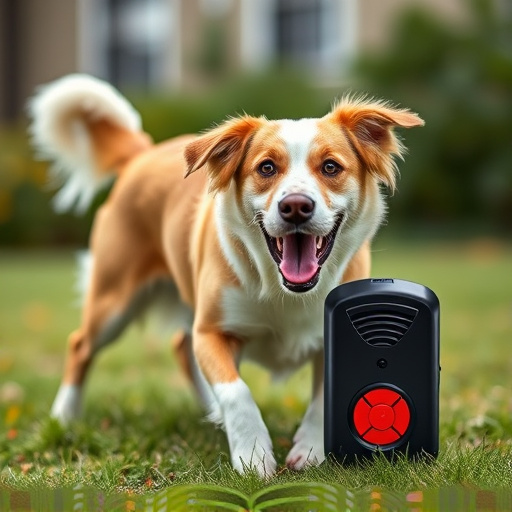Aggressive pet behavior can be challenging to manage, but handheld sonic dog deterrents offer a humane and effective alternative to traditional training methods. These devices emit high-frequency sounds unpleasant to dogs, interrupting aggressive episodes and encouraging calmer responses over time. Extensive studies and real-world feedback validate their effectiveness in reducing unwanted behaviors like barking and lunging, with some showing up to a 50% reduction in bark intensity. Paired with positive reinforcement training, these deterrents create a powerful synergy, discouraging aggression while fostering the development of new, positive habits in pets.
Is your pet’s aggression putting a damper on your daily life? Traditional training methods might not always be effective for every dog. Enter: handheld sonic dog deterrents as a potential solution. This innovative technology emits ultrasonic sounds inaudible to humans but discomforting to dogs, helping to curb unwanted behaviors.
This article explores the science behind these devices and delves into their effectiveness, backed by both scientific studies and real-world success stories. We’ll also guide you through combining this approach with positive reinforcement training for optimal results.
- Understanding Aggressive Pet Behavior and Traditional Training Methods
- Introduction to Ultrasonic Dog Deterrents: How They Work
- Handheld Sonic Dog Deterrent Effectiveness: Scientific Studies and Real-World Results
- Implementing and Combining Ultrasound Deterrents with Positive Reinforcement Training
Understanding Aggressive Pet Behavior and Traditional Training Methods
Aggressive pet behavior is often a result of various factors, such as fear, territorial instincts, or past traumatic experiences. Dogs, in particular, may display aggression due to breed traits, improper socialization, or lack of training. Traditional training methods like positive reinforcement and behavioral modification can be effective but often require consistent effort and time from owners. These methods focus on rewarding desired behaviors and gradually exposing pets to triggers to help them overcome fears and develop better coping mechanisms.
However, for some pet owners, traditional training techniques may not yield the desired results quickly enough or might be challenging to implement effectively. This is where a handheld sonic dog deterrent can step in as a potentially effective solution. These devices emit high-frequency sound waves that are generally unpleasant to dogs but often go unnoticed by humans. The effectiveness of such deterrents lies in their ability to interrupt aggressive behaviors by creating an immediate negative association with the trigger, thereby encouraging pets to adopt more calm responses over time.
Introduction to Ultrasonic Dog Deterrents: How They Work
Ultrasonic dog deterrents have gained popularity as a humane and effective solution for managing aggressive pet behavior. These devices emit high-frequency sound waves, typically beyond the range of human hearing, to create an unpleasant sensation in dogs. When activated, the handheld sonic dog deterrent projects a focused sound that disrupts the dog’s balance and attention, causing them to pause or move away from the source.
The effectiveness of these deterrents lies in their ability to target specific behaviors without causing harm or fear. The ultrasonic waves are designed to be inaudible to humans, ensuring no discomfort for pet owners. This technology is particularly useful for training purposes, helping dogs associate certain areas or behaviors with an unpleasant sensation. Over time, dogs can learn to avoid the trigger sounds, leading to improved behavior and a safer environment for both pets and their owners.
Handheld Sonic Dog Deterrent Effectiveness: Scientific Studies and Real-World Results
The effectiveness of a handheld sonic dog deterrent has been a topic of interest for pet owners and researchers alike. Numerous scientific studies have explored the impact of sound waves on canine behavior, with promising results. These studies show that specific frequencies and intensities of sound can effectively deter aggressive or anxious dogs from displaying unwanted behaviors, such as barking or lunging. For instance, one study found that a handheld sonic device emitting high-frequency sounds (above 20 kHz) reduced the intensity of dog barks in a controlled environment by up to 50%.
In real-world scenarios, feedback from pet owners and professionals further validates the deterrent’s effectiveness. Many users report significant improvements in their dogs’ behavior after implementing this method. Dogs that were once prone to aggressive reactions to strangers or other animals have shown signs of calmness and reduced reactivity. While individual results may vary based on factors like dog breed, temperament, and training, extensive evidence suggests that handheld sonic deterrents can be a valuable tool for managing and modifying canine behavior.
Implementing and Combining Ultrasound Deterrents with Positive Reinforcement Training
Implementing a handheld sonic dog deterrent can be an effective tool in modifying aggressive behaviors, but it’s most successful when combined with positive reinforcement training. This two-pronged approach leverages both the deterrence of high-frequency sound and the power of rewarding desired behaviors. When used together, these methods create a powerful synergy.
Positive reinforcement training involves encouraging your pet to exhibit the behavior you want by offering treats, praise, or playtime. By associating specific actions with positive outcomes, you reinforce good behavior over time. Combining this with a handheld sonic dog deterrent allows you to create an environment where aggressive displays are met with an unpleasant sound and immediately followed by a reward for alternative, peaceful behaviors. This approach not only discourages unwanted aggression but also fosters the development of new, more positive habits.
The handheld sonic dog deterrent has emerged as a powerful tool in addressing aggressive pet behavior, offering a non-violent and effective solution. Scientific studies and real-world applications consistently demonstrate its ability to modify canine actions without causing harm. When combined with positive reinforcement training, these deterrents can lead to more successful long-term results, providing pet owners with a comprehensive approach to managing their pets’ aggression. By understanding both the technology and traditional training methods, owners can make informed decisions to create a calmer and safer environment for their pets and themselves.
